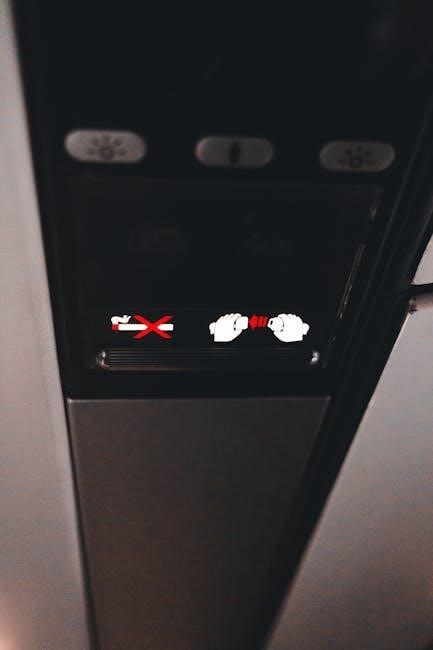zoom g1x four manual
The Zoom G1X Four is a versatile multi-effects pedal designed for guitarists, offering up to 5 simultaneous effects․ It features a built-in tuner, looper, and customizable patches․ Its 32-bit signal processing ensures high-quality tone shaping, making it ideal for both live performances and studio recordings․
1․1 Overview of the Zoom G1X Four
The Zoom G1X Four is a multi-effects pedal designed for guitarists, offering a wide range of effects and features․ It supports up to 5 simultaneous effects, with a variety of amp simulations, modulation, delay, and reverb options․ The pedal includes a built-in tuner, looper functionality, and customizable patches for versatility․ Its 32-bit signal processing ensures high-quality sound reproduction․ The G1X Four also features input/output options, auxiliary input support, and EQ/compression settings for precise tone shaping․ With its intuitive interface and robust connectivity, it is suitable for both live performances and studio use, making it a powerful tool for musicians seeking diverse sonic possibilities․
1․2 Key Features of the G1X Four
The Zoom G1X Four offers a comprehensive suite of features tailored for guitarists․ It includes a built-in tuner, looper functionality, and the ability to use up to 5 effects simultaneously․ The pedal supports 32-bit signal processing for high-quality sound reproduction․ Customizable patches allow users to tailor their tone, while the auxiliary input enables external audio integration․ Additional features include EQ and compression settings for precise sound shaping․ The G1X Four also supports firmware updates, ensuring access to the latest enhancements․ Its intuitive interface and robust connectivity make it a versatile tool for both live performances and studio recordings, catering to a wide range of musical needs․
1;3 Importance of the Manual
The manual is essential for unlocking the full potential of the Zoom G1X Four․ It provides detailed guidance on navigating the interface, understanding signal flow, and customizing effects․ By following the manual, users can optimize their sound quality, troubleshoot common issues, and master advanced features like the looper and firmware updates․ Whether you’re a beginner or an experienced guitarist, the manual serves as a comprehensive guide to maximizing the pedal’s capabilities․ It ensures users can explore all features confidently, achieving professional-grade tones and performances․

Signal Path and Connectivity
The Zoom G1X Four processes signals through a clear path, from input to output, with optional effects in between․ It supports multiple connectivity options, including auxiliary input, ensuring seamless integration with various setups․ The pedal’s 32-bit processing and 24-bit conversion maintain signal integrity, delivering high-quality audio․ Understanding the signal flow is key to optimizing your tone and connectivity for both live and studio use․
2․1 Understanding the Signal Flow
The Zoom G1X Four’s signal flow begins at the input, where the guitar signal is received and processed․ The signal then passes through the effects chain, allowing for customizable tone shaping․ The pedal’s 32-bit processing ensures high-quality audio throughout the journey․ Users can configure effects in any order, providing flexibility for unique sounds․ The signal then moves to the output section, where it is prepared for connection to amplifiers, mixers, or recording interfaces․ Understanding this flow is crucial for optimizing sound quality and achieving the desired tone․ The G1X Four’s intuitive design makes it easy to navigate and adjust the signal path․
2․2 Input and Output Options
The Zoom G1X Four offers a variety of input and output options to accommodate different setups․ The 1/4-inch input jack allows for direct connection of your guitar, while the auxiliary input enables external audio sources․ The main outputs provide both mono and stereo options, ensuring compatibility with various amplifiers and recording systems․ Additionally, the pedal features a headphone output for silent practice․ The G1X Four also supports MIDI connectivity, allowing for advanced control and integration with other MIDI-compatible devices․ These versatile input and output options make the pedal adaptable to both live performances and studio environments, catering to diverse musical needs․
2․3 Auxiliary Input (AUX IN) Usage
The Auxiliary Input (AUX IN) on the Zoom G1X Four allows you to connect external audio sources, such as a smartphone or music player, for backing tracks or practice sessions․ Simply plug in a 3․5mm audio cable to the AUX IN jack․ The AUX IN signal is mixed with your guitar sound, enabling seamless integration of external audio․ You can adjust the AUX IN level using the dedicated knob, ensuring the perfect balance between your guitar and external audio․ This feature is ideal for practicing with backing tracks or adding pre-recorded elements to your performances․ It enhances versatility during live and studio use․

Effects and Processing
The Zoom G1X Four offers a wide range of effects, including amp simulations, modulation, delay, and reverb, allowing for rich sound customization․ Advanced EQ and compression tools enable precise tone shaping, while the built-in tuner ensures accurate tuning․ The pedal’s 32-bit processing delivers high-quality audio, making it ideal for creating complex effects chains and achieving professional-grade sound․ Its versatility supports both live performances and studio recordings, catering to diverse musical styles and preferences․
3․1 Amp and Cabinet Simulation
The Zoom G1X Four features extensive amp and cabinet simulations, offering a wide range of tones for guitarists․ With multiple amp models and cabinet options, players can replicate classic sounds or create unique tones․ The pedal’s 32-bit processing ensures high-quality audio reproduction, delivering authentic amp and cabinet characteristics․ Guitarists can choose from clean, crunch, and high-gain amps, paired with various cabinet simulations to match their musical style․ This versatility allows for seamless transitions between genres, from rock to jazz, while maintaining consistent sound quality․ The simulations are highly customizable, enabling precise tone shaping to suit individual preferences․
3․2 Modulation Effects Overview
The Zoom G1X Four offers a diverse range of modulation effects, including phaser, flanger, chorus, and tremolo․ These effects provide dynamic tone shaping, from subtle texture to extreme sound manipulation․ Guitarists can customize parameters such as rate, depth, and resonance to achieve unique sounds․ The pedal’s intuitive interface allows for easy adjustment of modulation settings, enabling seamless integration into live performances or studio recordings․ With 32-bit processing, the G1X Four ensures high-quality modulation effects that retain clarity and definition․ Players can layer modulation effects with other processes to create complex, engaging tones tailored to their musical style․
3․3 Delay and Reverb Effects
The Zoom G1X Four features an extensive array of delay and reverb effects, offering guitarists rich spatial and temporal soundscapes․ Delay options include digital, analog, and tape delay, each with adjustable time, feedback, and level controls․ Reverb effects range from room to hall and plate simulations, providing immersive ambient textures․ These effects can be fine-tuned to suit various musical genres and playing styles․ The pedal’s 32-bit signal processing ensures pristine audio quality, maintaining clarity even with complex effect combinations; By integrating delay and reverb, players can craft expansive, professional-grade sounds effortlessly․
3․4 EQ and Compression Settings
The Zoom G1X Four offers robust EQ and compression tools to refine your tone․ The 3-band parametric EQ allows precise adjustments to bass, mid, and treble frequencies, while the graphic EQ provides a visual interface for detailed tone shaping․ Compression settings enable dynamic control, ensuring consistent volume levels and sustain․ Additional features like peak limiting and soft/hard knee compression offer versatility for different playing styles․ These tools are essential for creating balanced and polished sounds, catering to a wide range of musical genres and preferences; The G1X Four’s intuitive interface makes it easy to dial in the perfect tone with minimal effort․

Looper Functionality
The Zoom G1X Four features a user-friendly looper with up to 4 preset configurations․ It supports seamless recording, playback, and overdubbing, making it ideal for practice and performance․ Key settings include loop time, stop method, playback speed, and volume level․ This tool enhances creativity by allowing guitarists to build complex layers effortlessly․ The looper’s intuitive design ensures smooth operation, making it a valuable asset for both live and studio applications․
4․1 Looper Basics
The Zoom G1X Four’s looper is a powerful tool for creating and layering phrases․ It supports up to 4 tracks, allowing for intricate compositions․ Guitarists can record, playback, and overdub seamlessly․ Key settings include loop time, stop method, playback speed, and volume level, providing flexibility for various musical styles․ The user-friendly interface makes it easy to start and stop loops, while real-time adjustments ensure dynamic performances․ Perfect for practice, writing, or live shows, the looper enhances creativity and expands the possibilities of your sound․ Its intuitive design ensures smooth operation, making it accessible for musicians of all skill levels․
4․2 Configuring Looper Settings
Configuring the looper settings on the Zoom G1X Four allows for precise control over your loops․ Key settings include loop time, stop method, playback speed, and volume level․ These parameters can be adjusted to match your musical style and performance needs․ The looper supports up to 4 tracks and 16 minutes of recording time, enabling complex compositions․ Users can set the loop to play once or continuously and adjust the playback speed without altering the pitch․ Real-time volume control ensures seamless integration with your overall sound․ The intuitive interface simplifies the process, making it easy to tailor your looper settings for dynamic performances;
4․3 Best Practices for Using the Looper
To maximize the Zoom G1X Four’s looper, plan your loops in advance and use the sync feature to align them with your track’s tempo․ Adjust volume levels for each loop to maintain a balanced mix․ Labeling loops can enhance organization during live performances․ Practice with the looper before gigs to ensure smooth operation․ Utilize the undo/redo function to correct mistakes quickly․ Experiment with different settings to find the optimal configuration for your music․ Refer to the manual for detailed guidance and explore all features to enhance your looping experience․

Firmware Updates
Regular firmware updates enhance the G1X Four’s performance by adding new features and fixing issues․ Use Zoom Guitar Lab to update and backup settings before proceeding․ Follow manual instructions carefully․
5․1 Checking Current Firmware Version
To ensure optimal performance, regularly check the G1X Four’s firmware version․ Connect the pedal to your computer via USB and launch the Zoom Guitar Lab software․ Navigate to the “Device” or “Settings” tab within the software․ The current firmware version will be displayed here․ Compare it with the latest version available on Zoom’s official website․ If an update is available, follow the on-screen instructions to download and install the new firmware․ Keeping the firmware up-to-date ensures access to new features, bug fixes, and improved functionality․
5․2 Updating Firmware on Windows
To update the G1X Four’s firmware on Windows, connect the pedal to your computer via USB․ Download the latest firmware from Zoom’s official website and extract the ZIP file․ Launch the firmware update application included in the download․ Select the extracted firmware file and follow the on-screen instructions to complete the update․ Ensure the device remains connected throughout the process to avoid interruptions․ Once the update is successful, restart the G1X Four to apply the changes․ This ensures you have the latest features and improvements for optimal performance․
5․3 Updating Firmware on macOS
To update the G1X Four’s firmware on macOS, connect the pedal to your computer via USB․ Download the latest firmware from Zoom’s official website and extract the ZIP file․ Open the Guitar Lab software or the provided firmware update application․ Select the extracted firmware file and follow the on-screen instructions to complete the update․ Ensure the device remains connected throughout the process to prevent any issues․ Once the update is confirmed successful, restart the G1X Four to apply the changes․ This ensures compatibility and access to the latest features and improvements for enhanced performance․

Effects Customization
The G1X Four allows you to create custom patches, adjust effect levels, and reorder effects to suit your sound preferences, enabling tailored tone shaping for any genre or style․
6․1 Creating Custom Patches
The Zoom G1X Four allows you to craft unique custom patches by combining up to 5 effects in any order․ Users can select from a variety of built-in effects, including amp simulations, EQ, compression, and modulation․ Each effect within a patch can be individually adjusted to fine-tune your sound․ The pedal’s intuitive interface makes it easy to navigate and customize settings․ Additionally, the Zoom Guitar Lab software enables deeper customization, allowing you to download and sync new patches directly to the G1X Four․ This flexibility ensures that you can create tones tailored to your playing style and musical genre, making your sound truly personalized․
6․2 Adjusting Effect Levels
Adjusting effect levels on the Zoom G1X Four allows precise control over the balance of each effect in your tone․ Users can tweak individual effect parameters, such as delay time or reverb amount, using dedicated knobs or the intuitive menu system․ The pedal offers a wet/dry mix option for many effects, enabling you to blend processed and clean signals seamlessly․ This feature ensures that your overall sound remains balanced and tailored to your musical style․ By fine-tuning effect levels, you can enhance specific elements of your playing, whether it’s for subtle ambiance or bold, expressive solos․
6․3 Organizing Effects in Any Order
The Zoom G1X Four allows users to organize effects in any order, providing flexibility in creating unique tones․ This feature ensures that players can tailor their signal chain to suit specific musical styles or preferences․ By rearranging effects, such as placing distortion before or after reverb, users can achieve distinct sonic textures․ The pedal supports up to 5 simultaneous effects, and the order can be adjusted via the menu system or using the Zoom Guitar Lab software; This customization capability enhances creativity and ensures that the effects workflow aligns perfectly with the player’s artistic vision․

Tuner and Octave Functions
The Zoom G1X Four features a built-in chromatic tuner for precise tuning and an octave effect to add lower or higher octaves, enhancing tonal possibilities․
7․1 Using the Built-in Tuner
The Zoom G1X Four’s built-in tuner provides accurate tuning for your guitar․ To use it, press and hold the TUNER button or navigate to the tuner menu․ The display will show a needle indicating pitch․ When the needle is centered, your note is in tune․ The tuner supports standard and open tunings․ For precise tuning, ensure the input signal is clean and avoid background noise․ You can mute the output during tuning to avoid feedback․ The tuner’s sensitivity adjusts automatically, ensuring reliable performance for both quiet and loud playing․ This feature is essential for maintaining professional sound quality during performances or recordings․
7․2 Adjusting Tuner Sensitivity
To adjust the tuner sensitivity on the Zoom G1X Four, navigate to the tuner settings menu․ Use the cursor buttons to select Sensitivity and press ENTER․ Choose from preset sensitivity levels or adjust manually for precise tuning․ Higher sensitivity is ideal for quiet playing, while lower settings suit louder environments․ Save your preferences to ensure consistent tuning accuracy․ This feature ensures the tuner adapts to your playing style, providing reliable performance during live gigs or practice sessions․ Proper sensitivity adjustment enhances tuning speed and accuracy, making it a crucial step for maintaining professional sound quality․
7․3 Engaging the Octave Effect
To engage the octave effect on the Zoom G1X Four, navigate to the effects menu and select the Octave option․ Use the cursor buttons to choose from multiple octave types, including +1 Octave and -1 Octave․ Adjust the Level parameter to balance the octave tone with your original signal․ The octave effect adds depth to your sound by layering it with a pitch-shifted version․ Experiment with blending levels to create unique textures or enhance bass lines․ This feature is particularly useful for adding richness to solos or rhythm parts, making it a versatile tool for creative expression․

Zoom Guitar Lab Software
Zoom Guitar Lab is software for managing the G1X Four, enabling patch customization, effect tweaking, and seamless syncing․ It’s a powerful tool for organizing your sounds effectively․
8․1 Installing Guitar Lab
Installing Zoom Guitar Lab is straightforward․ Download the software from Zoom’s official website, ensuring compatibility with your OS (Windows/macOS)․ Run the installer, following on-screen instructions․ For Windows, extract the ZIP file and run the setup․ On macOS, open the DMG and drag the app to Applications․ After installation, connect your G1X Four via USB․ Restart your device if prompted․ Guitar Lab will recognize your pedal, allowing you to manage patches, update firmware, and customize effects seamlessly․ Ensure your G1X Four is updated to the latest firmware for optimal compatibility with Guitar Lab․
8․2 Navigating the Guitar Lab Interface
The Guitar Lab interface is user-friendly, with a clean layout designed for intuitive navigation․ Upon opening, you’ll see a main window displaying your G1X Four’s current setup․ The left panel provides access to patch libraries, while the right side shows the effects chain․ Use the toolbar at the top to manage tasks like importing/exporting patches or updating firmware․ The central area allows detailed editing of effects, EQ, and compression settings․ Drag-and-drop functionality enables easy reordering of effects․ A dedicated section at the bottom displays real-time signal processing details․ This organized structure ensures efficient customization and management of your sound preferences․
8․3 Syncing Patches with the G1X Four
To sync patches with the G1X Four, connect the pedal to your computer via USB and launch Zoom Guitar Lab․ Select the G1X Four from the device list in the software․ Browse the patch library to select desired sounds, then click “Import” to transfer them to the pedal․ Use the “Export” feature to save custom patches from the G1X Four to your computer․ Ensure your device is updated to the latest firmware for seamless syncing․ The interface allows easy organization and transfer of patches, enabling quick access to your favorite tones during performances or recordings․

Troubleshooting Common Issues
Resolve connection problems by restarting the G1X Four and ensuring proper USB and AUX connections․ Check firmware updates and consult the manual for specific error solutions․
9․1 Resolving Connection Problems
To resolve connection issues with the Zoom G1X Four, start by restarting the device and ensuring all cables are securely connected․ Check both USB and AUX inputs for proper functionality․ If using a computer, verify that the correct audio interface is selected in your system settings․ Update the firmware to the latest version, as outdated software can cause connectivity problems․ Consult the manual for specific troubleshooting steps or reset the device to factory settings if issues persist․ For persistent problems, contact Zoom support for further assistance․
9․2 Fixing Audio Latency Issues
Avoid audio latency on the Zoom G1X Four by optimizing settings․ Ensure the buffer size is set to the lowest stable value in your DAW or recording software․ Use a USB 2․0 port for reliable connection and disable any unused USB devices․ Update audio drivers and firmware to the latest versions․ Enable high-performance power settings on your computer and disable power-saving modes․ Close unnecessary background applications to reduce system resource strain․ If latency persists, consider resetting the device to factory settings or consulting the manual for advanced troubleshooting steps․
9․3 Addressing Firmware Update Failures
If a firmware update for the Zoom G1X Four fails, restart the device and computer, then retry the process․ Ensure a stable internet connection and use the original USB cable․ Verify that Zoom Guitar Lab software is up to date, as outdated versions may cause issues․ If the update fails again, check for corrupted files and redownload the firmware․ Disable antivirus or firewall temporarily, as they may block the update․ If problems persist, perform a factory reset before retrying․ Consult the troubleshooting guide or contact Zoom support for further assistance to resolve the issue effectively․

Tips for Optimal Sound Quality
Optimize your sound by using high-quality cables, minimizing unnecessary effects, and adjusting EQ settings․ Utilize the built-in 32-bit processing for clear tone and maintain proper gain staging․
10․1 Choosing the Right Effects Chain
Selecting the appropriate effects chain is crucial for achieving desired tones․ Start with essential effects like tuner and compression to maintain consistency, followed by overdrive or distortion for gain․ EQ is next to shape your tone, ensuring clarity and balance․ Reverb or delay can add depth and space to your sound․ Experiment with different orders to suit your playing style and genre․ The Zoom G1X Four allows up to 5 effects simultaneously, so prioritize based on your musical needs․ Proper arrangement ensures a clean, professional sound without overwhelming the signal path․
10․2 Adjusting Output Levels Properly
Properly adjusting output levels is essential for maintaining sound quality․ Start by setting the master volume control to an appropriate level, ensuring it matches your setup․ Use the output level knob to balance the signal strength, avoiding distortion or signal loss․ Ensure consistency across all patches and effects chains by fine-tuning each output level․ Regularly check cable connections to confirm they are secure and functioning correctly․ This step ensures optimal signal integrity and prevents unwanted noise or hum․ Refer to the manual for specific output level settings tailored to your equipment configuration․
10;3 Maintaining Signal Integrity
To maintain signal integrity, ensure all connections are secure and use high-quality cables․ Position the G1X Four away from devices that may cause electromagnetic interference․ Regularly inspect and clean input/output jacks to prevent dirt or corrosion from degrading the signal․ Avoid overly long cable runs, as they can introduce noise․ Use the built-in noise reduction features if necessary․ Keep the pedal firmware updated to ensure optimal performance․ By following these steps, you can preserve the clarity and quality of your guitar tone throughout your effects chain․
The Zoom G1X Four is a powerful, versatile multi-effects pedal offering extensive tonal possibilities․ With its rich features and intuitive design, it empowers guitarists to explore endless creative possibilities․
11․1 Summary of Key Features
The Zoom G1X Four is a powerful multi-effects pedal designed for guitarists, offering a wide range of tonal possibilities․ It features a built-in tuner, looper, and customizable patches, allowing for up to 5 simultaneous effects․ The pedal includes amp and cabinet simulations, modulation effects, delay, reverb, EQ, and compression․ With 40 preset patches and 32-bit signal processing, it ensures high-quality sound․ The G1X Four also supports firmware updates and integration with Zoom Guitar Lab software for patch management․ Its intuitive interface and robust features make it ideal for both live performances and studio recordings, catering to diverse musical styles and preferences․
11․2 Encouragement to Explore Further
With the Zoom G1X Four, the possibilities for shaping your sound are endless․ Experiment with its diverse effects, from amp simulations to modulation, to create unique tones․ Dive deeper into the looper functionality to craft intricate layers and textures․ Explore the customizable patches and organize effects to suit your style․ The G1X Four is designed to inspire creativity, so don’t hesitate to push its limits․ Whether you’re refining your sound in the studio or performing live, this pedal offers the tools to take your music to the next level․ Keep exploring and discovering new ways to express your artistry․






























